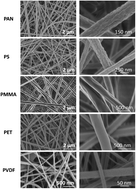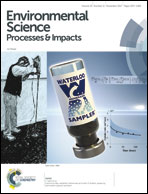Emerging investigator series: development and application of polymeric electrospun nanofiber mats as equilibrium-passive sampler media for organic compounds†
Abstract
We fabricated a suite of polymeric electrospun nanofiber mats (ENMs) and investigated their performance as next-generation passive sampler media for environmental monitoring of organic compounds. Electrospinning of common polymers [e.g., polyacrylonitrile (PAN), polymethyl methacrylate (PMMA), and polystyrene (PS), among others] yielded ENMs with reproducible control of nanofiber diameters (from 50 to 340 nm). The ENM performance was investigated initially with model hydrophilic (aniline and nitrobenzene) and hydrophobic (selected PCB congeners and dioxin) compounds, generally revealing fast chemical uptake into all of these ENMs, which was well described by a one compartment, first-order kinetic model. Typical times to reach 90% equilibrium (t90%) were ≤7 days under mixing conditions for all the ENMs and <0.5 days for the best performing materials under static (i.e., no mixing) conditions. Collectively, these short equilibrium timescales suggest that ENMs may be used in the field as an equilibrium-passive sampler, at least for our model compounds. Equilibrium partitioning coefficients (KENM–W, L kg−1) averaged 2 and 4.7 log units for the hydrophilic and hydrophobic analytes, respectively. PAN, PMMA and PS were prioritized for additional studies because they exhibited not only the greatest capacity for simultaneous uptake of the entire model suite (log KENM–W ∼1.5–6.2), but also fast uptake. For these optimized ENMs, the rates of uptake into PAN and PMMA were limited by aqueous phase diffusion to the nanofiber surface, and the rate-determining step for PS was analyte specific. Sorption isotherms also revealed that the environmental application of these optimized ENMs would occur within the linear uptake regime. We examined the ENM performance for the measurement of pore water concentrations from spiked soil and freshwater sediments. Soil and sediment studies not only yielded reproducible pore water concentrations and comparable values to other passive sampler materials, but also provided practical insights into ENM stability and fouling in such systems. Furthermore, fast uptake for a suite of structurally diverse hydrophilic and moderately hydrophobic compounds was obtained for PAN and PS, with t90% ranging from 0.01 to 4 days with mixing and KENM–W values ranging from 1.3 to 3.2 log units. Our findings show promise for the development and use of ENMs as equilibrium-passive samplers for a range of organic pollutants across soil/sediment and water systems.

- This article is part of the themed collection: Emerging Investigator Series


 Please wait while we load your content...
Please wait while we load your content...